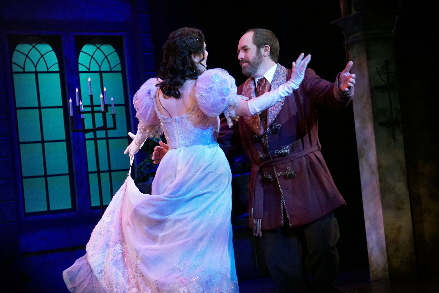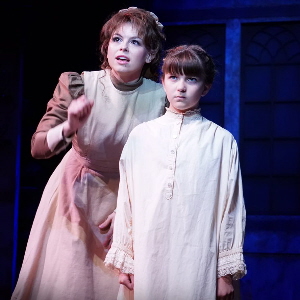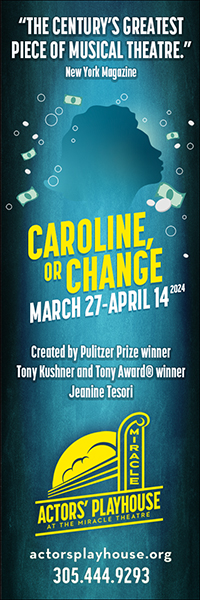
The ghost of Lily (Elizabeth Sackett) dances but does not touch Archibald (Michael Ursua) in a reverie during Slow Burn Theatre’s production of The Secret Garden / Photos by Rodrigo Balfanz
By Bill Hirschman
“In this time of cold and darkness, in this terrifying night, in this seemingly endless winter,” to quote the musical Celebration, the themes of regeneration and resurrection in The Secret Garden are even more a welcome message of hope in 2017 than when the musical bowed in 1991.
Be grateful that Slow Burn Theatre Company with its audacious affection for large scale challenging musicals has decided to mount this ode to rebirth, memorable for its lush unconventional score that resembles streams of music intertwining into an aural waterfall.
Like many Slow Burn choices that are this difficult, there are shortcomings in this production, but those deficiencies are overwhelmed by a cornucopia of theatrical blessings encompassing glorious voices, moving acting and a unique visual style.
The 1911 children’s novel by Frances Hodgson Burnett, still considered a classic of its genre a century later, was adapted from 1989 to 1991 by acclaimed playwright Marsha Norman (‘night Mother) and Lucy Simon, then only known as a folk and rock composer.
The result, which was reworked in later years, has several changes from the book which more deeply explore the adults’ tumult. Indeed, the musical is inextricably infused with the idea that death does not end relationships; they endure molding the lives of the survivors. With a chorus of white-garbed spirits commenting throughout, death and loss visibly are the inevitable blight that must be mitigated by attention and caring before lives can regenerate.
The plot tells of Mary Lennox, a 10-year-old living in the British Raj whose family is wiped out overnight by cholera. Sour, rude and withdrawn, she is sent to the Yorkshire mansion of her only living relative, her uncle Archibald Craven. He remains devastated by the death of his beloved wife Lily ten years earlier in childbirth. More crippled by memory than the hump on his back, he cannot escape visions of her.
Misselthwaite Manor is a dark gothic world on the moors with mysterious moans and cries punctuating the middle of the night. All of it is haunted by ghosts of Mary’s family lost in the plague as well as Lily and her friends. As Archibald withdraws from human contact, his jealous brother continues to mourns Lily whom he loved from afar.
With Craven’s refusal to see Mary, the dour girl slips into a tentative relationship with Martha, the nurturing chambermaid, and her brother Dickon, a mysterious soul deeply ingrained in nature. Along with the elderly gardener Ben, Mary discovers Lily’s large walled garden, now seemingly dead and put off limits by Craven.
But stirrings of life emerge when they start to reclaim the garden and when Mary discovers that the nighttime sounds come from Craven’s bedridden son Colin who needs emotional rescuing as well.
The dank gloom in all its manifestations is driven away and characters come to terms with their loss amid the reawakening of life both horticultural and emotional.
Slow Burn co-founder Patrick Fitzwater once again shows how his choreography background influences his directorial vision. Everything swirls from the ballroom dancing, to the ghosts spinning Archibald around in his chair as if in an emotional maelstrom, to simply sliding on garden walls with a circular spinning motion. He elicits effective acting performances from the cast although no one seems to have much chemistry other than Mary and Martha.
One failure is that the production never communicates the feeling of magic that is supposed to imbue the entire evening. In fact, the weakest part of the show is a bizarre scene in which Dickon, Ben, Martha and Mary conjure strength into Colin’s legs with risible incantations, gesticulations and gyrations.
Another shortcoming is that the narrative is hard to follow if you haven’t read the book, seen one of the film versions or spent five minutes on Wikipedia. Crucial disclosures of plot and relationships are passed on in muffled lyrics or a single line of dialogue, and therefore easily missed. Indeed, the introductory minutes are baffling with a little girl contemplating a Victorian dollhouse and then gliding people in white including some guy in a turban dancing with red and white handkerchiefs. Previous visitors to the garden know what this is about, but it’s several minutes before it’s explained to the newcomers and even then it doesn’t completely make sense. (What do the white handkerchiefs symbolize?)
Finally, a good deal of the show occurs too far back on the stage, creating an emotional distance that makes the audience yearn for the action to play out closer to them.
On balance, though, the production’s assets would fill a ledger, starting with the performances. As Mary, Alexa Lasanta of Jupiter, who was on the recent national tour of The Sound of Music, has the necessary clarion voice and just enough charisma to carry the audience through the journey. Her transformation is not as gradual as you might want, but she glows when Mary finds the family she craves.
Michael Ursua, best known locally as a musical director and soloist, nails the emotional center in his second consecutive lead role this season as Archibald – far different than his Zaza in MNM’s La Cage aux Folles. With tragically sad eyes and an emotion-filled voice, Ursua scales the heights of musical theater singing with his “Where In The World” lament and “How Could I Ever Know,” surpassed only by his duet with the equally moving Matthew Korinko as his brother in their soaring duet, “Lily’s Eyes.”
Slow Burn co-founder Korinko, who infuses a fine baritone with passionate acting, is an example of how brilliantly the show has been cast with actors who can sing. That quality is true of the leads such as the lovely Elizabeth Sackett’s near operatic soprano trill as the glowing essence of Lily, but also extending down through the secondary and tertiary characters.

Anne Chamberlain and Alexa Lasanta
For instance, it’s always a certified treat to see and hear a performance from Anne Chamberlain, returning home briefly from New York to inhabit the lively maternal chambermaid Martha. Out-of-towner Kyle Kemph brings an impish lifeforce to Dickon. (Both have a convincing Yorkshire accent). But even the smaller parts of Mary’s dead parents are given far-above-average renderings from major vocal talents Ann Marie Olson and Michael Cartwright. Even Christo Joseph Amygdalitsis, who was the young Tarzan at Slow Burn a month or so ago, makes a convincingly mercurial invalid Colin.
Rounding out the cast are Aaron Bower, Michael Kreutz, Erin Pittleman, Rick Pena, Stephanny Noria, Casey Sacco, Chris Robertson, Sahid Pabon, Johnbarry Green, Kimmi Johnson, Andrew Rodriguez-Triana and Leigh Shani Green.
Musical director Brad Simmons does a masterful job with this difficult score. Simmons excels leading the seven-piece band, although cast album devotees might wish for a bit more breadth and depth in the size of the orchestra. But his real achievement is molding and stirring together the voices into lovely duets, trios, quartets and full out chorales. This isn’t minor. Unrestrained by traditional tropes, Lucy Simon’s unique quirky score contains some “tunes” but is more free-form and far more complex than a score by Jerry Herman or Andrew Lloyd Webber.
The only complaint is that sometimes Norman’s gorgeous lyrics get lost in the tumult, although the power of the acting and the music make the meaning clear.
The elaborate Broadway set design won Heidi Landesman a Tony Award, but Michael McClain hasn’t got that budget. Still he creates an evocative environment of the gloomy haunted house and the resplendent garden, each effectively illuminated by Thomas M. Shorrock, although some singers occasionally seemed to be unlit, perhaps due to a limited number of lighting instruments.
The exquisite period costumes were overseen by Rick Pena who designed some, built some, and borrowed some including pieces from Costume World Theatrical which owns the Broadway garb.
On the whole, Slow Burn’s skill and passion produce a truly beautiful evening of theater that uplifts the spirit.
The Secret Garden presented by Slow Burn Theatre Company through Dec. 31 at the Amaturo Theater, Broward Center For The Performing Arts, 201 SW 5th Ave., Fort Lauderdale. Performances are Thursday through Saturday at 7:30 p.m., Wednesday at 1 p.m. and Sunday at 2 p.m. Running time about 2 hours 30 minutes including one intermission. Tickets are $25-$60. Call (954) 462-0222 for tickets, at www.browardcenter.org or #Ticketmaster.com; in person at Ticketmaster outlets or the Broward Center’s Auto Nation Box Office. Info at www.slowburntheatre.org








 A PaperStreet Web Design
A PaperStreet Web Design

One Response to Slow Burn Hosts Lovely Swirling Visit To The Secret Garden